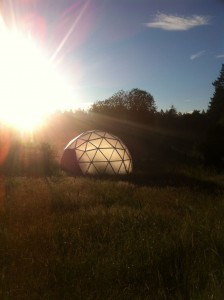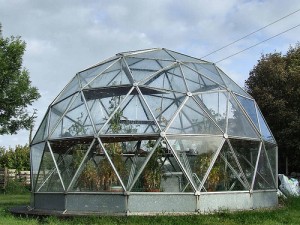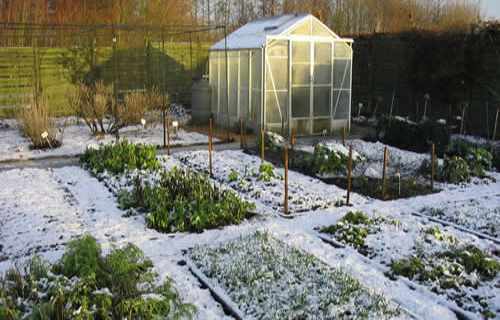If you are aiming for a more self-sufficient way of life, growing your own food usually fits somewhere into that equation. For those of us living in more northerly, cold climes, small-scale food production can vary widely to adapt to shorter growing seasons and to boost production, whether it means using hoop houses (1), low tunnels, coldframes (2), or even underground greenhouses(3):
3.Low-Cost, Multipurpose, DIY Greenhouses…No Way To Resist That.
While extending the growing season late into autumn is an attractive proposal, there are some that contend that one can harvest certain veggies well into winter. Harborside, Maine organic farmer, author and agricultural researcher Eliot Coleman is one of these people, having taught himself how to grow food during harsh northeastern winters after years of experimentation.
Using unheated or minimally heated greenhouses, Coleman and his wife, gardening author Barbara Damrosch, cultivate the 1.5-acre Four Season Farm, producing hardy plants like carrots, potatoes, various greens like spinach, watercress, mâche, mesclun, and even artichokes year-round, on a commercial scale.
Seen in the videos here, his explanation of his low-tech, experimental but proven methods is fascinating. Located at the 44th parallel, Coleman uses plastic-covered hoop houses and greenhouses to simulate growing conditions 500 miles south of his farm.
Adding another supplemental layer of light, permeable material 11 inches above (a “floating row cover”), helps to emulate a climate thousands of miles south.
Planting at the right time for your conditions and environment is also crucial, he says. “For example, the trick with winter-harvest crops is to get the seeds in the ground in September, not November, so the crop has a chance to grow and put out new leaves,” he explains. “I think of August-September as the second spring.” Successive seedings also ensure a continual harvest.
Dry Age stems from a time when there were still large herds of buffaloes grazing on the prairies. The animals that were shot were severed into big technical parts and transported to the big cities in untilled steam train wagons. It was discovered that, by taking out certain planks from the wagon and letting in a sufficient mass of air stream into the wagon, the meat would turn black but stayed wonderfully red inside. Moreover, it didn’t perish and the taste became more tender and much more flavor some. Even old-fashioned butchers were impressed by this modern-day process although it was applied with varying degrees of success in those days
So, you will understand that we have tried, tested and further developed this old know-how and adapted it to our present-day needs. In doing so we focused solely on meat.
The Carnivore’s Bible system developed by us gives the best possible results ever obtained so far. One of the biggest advantages is its dynamic operating system: it is capable of making a pretty accurate estimate of the quantity of meat to be dried and the stages of the ripening process inside the cabinet. After that, in steps and stages, the process can either be speeded up or slowed down. In this way it is possible to place both fresh meat and meat in various stages of ripening in one and the same cabinet.
All our Dry Age cabinets are partly or completely see-through. You can perfectly witness the changes in the meat and bring these quality products to the attention of your customers and guests. People are usually greatly interested and have a lot of questions to ask.
Proves you can grow your own food, 365 days of the year, no matter where you live. After all, her garden is “perched on the edge of the Atlantic Ocean in the Great White North,” as she writes in her book. And just look at the greens she’s growing in December!
 A geodesic dome looks much like a ball cut in half. Due to its shape, the dome is durable and reliable. They are built to use maximum space while using the least amount of surface area. One benefit of the dome is that it allows the most amount of light to hit all points of the structure, unlike many other greenhouses with may have shady spots or hot spots. This structure also allows plenty of room for vertical growing.
A geodesic dome looks much like a ball cut in half. Due to its shape, the dome is durable and reliable. They are built to use maximum space while using the least amount of surface area. One benefit of the dome is that it allows the most amount of light to hit all points of the structure, unlike many other greenhouses with may have shady spots or hot spots. This structure also allows plenty of room for vertical growing.
While this is a superior type of greenhouse, there is one that is even more beneficial and it’s called the biodome.
Biodome
 While biodomes come in the same shape as a geodesic dome, they are actually much better in a number of ways and the two shouldn’t be confused.
While biodomes come in the same shape as a geodesic dome, they are actually much better in a number of ways and the two shouldn’t be confused.
Biodomes are self contained ecosystems which are controlled to closely resemble a natural environment. An example of this is at the Montreal Biodome in which there are four different ecosystems that visitors can explore. One is based on the South American rainforest, one on the North American wilderness, one on an estuary, and the last one on a polar area that has been divided into an Arctic side and a Antarctic side. This is done by keeping the inside of the biodome precisely controlled.
A biodome, once established, is able to be self sufficient and regenerate its own water and nutrients. There is no need for outside intervention once it is set up and running. However, the purpose of a biodome as a garden is to create the perfect environment for growing your own food source. Biodomes, when built large enough, can also play host to insects and animals.
The benefits of owning a biodome are many and various. Using a biodome for growing food means you can have the perfect temperature and ‘season’ all year long. Unlike a traditional greenhouse, cucumbers and lettuce in the winter are no problem, and neither is cantaloupe in the spring. They save money when it comes to water and energy because the inside of the biodome is regenerative. When using a biodome to grow food, it is easy to determine the exact amount of growing time each different vegetable will need, giving growers the ability to plan exactly when to plant and harvest, making it easy to have enough of any given vegetable at any given time.
Seedlings that are grown in a biodome grow faster than those grown in a hot bed or by other methods. They are not only stronger, but more resilient as well. They can survive being transplanted to a garden easier, if sharing your plants with neighbors, friends, or family is something you’re considering. Biodomes are also good at keeping out bugs and viruses plants can become sick with. The biodome is designed to keep these things out.
The outside of the biodome works much like the geodesic dome in that the sun will not overheat one area or be affected by shade. Plants don’t dry out or even get too much or too little of any given nutrient.
For those who are interested, the biodome can be used for both aquaponics and also for hydroponics. Biodomes are typically a little larger than other types of greenhouses, so in addition to being able to control the environment, there are many more options of how to use the biodome, some of which aren’t possible in one of the more conventional greenhouses. If space is an issue, a smaller sized biodome will work just as good as a large one.
When biodomes are built correctly, they can withstand a variety of environmental factors. Because of the way the biodome is structured, it is very strong and can withstand a lot of pressure. It is best if they are screwed in and bolted down to the ground, so they can even withstand small tornadoes and earthquakes. Many biodomes are builder friendly with simple construction and overall can be more cost effective than many greenhouses.
Biodomes, once unscrewed or unbolted from the ground, are portable and easy to move. Because of this, many cities and towns don’t require building permits as they are considered temporary structures, although it is important to check local building codes.
Biodomes have superior ventilation and are energy efficient due to their shape. Since heat rises, many greenhouses will stay hotter near the top. With a biodome, the heat rises to the top, then naturally gets pushed down as more heat keeps rising, keeping the dome the same temperature year round. A small window inserted at the top of the biodome allows excess hot air to vent, while the vent at the base of the biodome allows cold air in. This exchange keeps the air moving and continually fresh, making the inside of the biodome the perfect place to grow a variety of vegetables.
As people begin to realize how to get back to doing things the way they were for years, there is naturally a learning curve. Whether it’s learning to hunt, can, or even sew, it all takes time. Using a biodome to grow vegetables can decrease the learning curve exponentially when it comes to gardening and a family can be up and running with fresh produce in no time. As time and money are factors for many people, the biodome may be the perfect answer for families.
Biodomes are used by many people in countries all over the world, with great success. As times become harder, money tighter, and dependency on the grid ever more frightening, doing more things for ourselves becomes even more important. Learning about using heirloom seeds in the biodome can help to keep a garden up and running for years to come. Having a garden is a big step in being self sustaining, and knowing where the food is coming from. Gardeners determine what chemicals come in contact with the food, whether or not to use GMO seeds, and other factors. Fresh, healthy produce is readily available year round, making the biodome the best option for most people.
The Year-Round Vegetable Gardener taught me a lot about how the growing season can be extended from an early jump start in the spring to fall planning for winter harvests. Even after all these years of vegetable gardening, I find this book is one of those garden resources I’ll reach for again and again.
“MY SURVIVAL FARM”
…and it’s like nothing you’ve ever seen before… An A to Z guide on survival gardening that is easy to read and a joy to put into practice, full of photos, diagrams and step by step advice. Even a kid can do this and, in fact, I encourage you to let the little ones handle it, to teach them not just about self-reliance but also about how Mother Nature works.
Here is just a glimpse of what you’ll find inside:
How to plan, design and put into action high-yield survival garden that will literally keep you and your family fed for life, no matter what hits you, even when everyone else around you is starving to death. No digging and planting year after year and no daily watering because you’ll have more important things to worry about when TSHTF.
How to set up highly nutritious soil for your plants. Do this before you plant anything and you’re on your way to setting your food forest on auto-pilot for decades to come. I’m gonna tell you this one “weird” thing to add to the mulch that’s not only highly effective but also 100% free (because you already have it in your home right now).
Step-by-step instructions on how to plant over 125 plants inside your permaculture garden. Plus, special instructions on choosing the right ones for your climate. From Arizona to Alaska, you can do this anywhere…
How to “marry” your plants. We’re gonna tell you which grow well together and help each-other survive and thrive, so they don’t ever compete for sunlight and nutrients. You get the full table of plants that work well with one another as well as the ones you should NEVER be put together.
The Lost Ways is a far–reaching book with chapters ranging from simple things like making tasty bark-bread-like people did when there was no food-to building a traditional backyard smokehouse… and many, many, many more!
Books can be your best pre-collapse investment.
Carnivore’s Bible (is a wellknown meat processor providing custom meat processing services locally andacross the state of Montana and more. Whether your needs are for domestic meator wild game meat processing)
The Lost Book of Remedies PDF ( contains a series of medicinal andherbal recipes to make home made remedies from medicinal plants and herbs.Chromic diseases and maladies can be overcome by taking the remediesoutlined in this book. The writer claims that his grandfather was taughtherbalism and healing whilst in active service during world war twoand that he has treated many soldiers with his home made cures. )
Easy Cellar(Info about building and managing your root cellar, plus printable plans. The book on building and using root cellars – The Complete Root Cellar Book.)
The Lost Ways (Learn the long forgotten secrets that helped our forefathers survive famines,wars,economic crisis and anything else life threw at them)
LOST WAYS 2 ( Wordof the day: Prepare! And do it the old fashion way, like our fore-fathers did it and succeed longbefore us,because what lies ahead of us will require all the help we can get. Watch this video and learn the 3 skills that ensured our ancestors survival in hard times offamine and war.)


